
B I O M E C H A N I C A L ' I N S E C T ' ?
RIDLEY SCOTT: 'It's like a rather beautiful, humanoid, biomechanoid insect.' (Making of Alien 2003)
RIDLEY SCOTT: "I wanted them to be insect-like. Like an ant, because if we examine an ant under a microscope they're kind of elegant. And I wanted him to be elegant and dangerous." (The Alien Saga Documentary 2002)
When James Cameron continued the story of 1979's Alien, he contributed some memorable and iconic additions to the Alien nature and biology, but continued to draw from the very same inspirations the original filmmakers did - insects.
______________________________________________________________________________________

The alien creature, depending whether you ask Ridley Scott or Dan O'bannon, is either a natural animal or insect or - both. Bottom line is, all creative forces behind the original creatures drew from the nightmarish world of insects, and recognize the beast as being fully or at least partially one.
Ridley Scott: 'Whether he [the Alien] could see, or simply sense
like an insect, I didn't need ever have to answer that question'
'He [Skerret] is really the host for the insect, which is the Alien.'
Ridley Scott: 'There are insects like that [androgynous, asexual], so we based that on a little bit of good old Mother Nature.'
HR Giger: ‘We decided to make a very elegant creature, quick and like an insect.’ - Giger
The alien's life cycle is perhaps one of the most apparent area where the influence can be recognized
Ron Shusset:
'People have read all kinds of things into it that we didn’t intend, not even
subconsciously. But there was one thing we did do. It was our idea that it would
be the life-cycle of an insect. The way a wasp will sting a spider, paralyze it,
and lay its eggs in the spider; its eggs grow off the living spider, like a
surrogate mother. That we did want it to be. We didn’t want it to be a human
mated with an alien and a hybrid. We thought people might pick up on it and say,
‘Yeah, an alien life-cycle can be like an insect life-cycle.’
Ron Cobb: '[T]hat
was the core of the idea that Dan had about the [chestburster scene], he got
that from the paralyzing wasp, you know, it paralyses the spider and lays its
eggs on the spider, then buries it in the ground so that the living spider
serves as food for the uh, wasp larva and you know, he always was so horrified
at that idea.'
Ridley Scott: 'There's a fundamental connection in nature because we actually watched, in preparation for this, Oxford Scientific had this interesting piece of footage where they'd watched a slice of bark - which, in our terms, to a human being, would be about 12 feet thick - and there's a grub underneath the bark, between the bark and the tree. There's always a space between the bark and the tree. Across the top of the bark was this insect, which passes over the grub, stops, backs up, and "feels" the grub is there let's say, the equivalent of 8 foot below you. It goes up on its hind legs, produces a needle from between its legs, and drills through the bark and bulls-eyes right into the grub and lays its seed, so that the grub becomes the host of the insect. And does what comes out of the union between the grub and the insect, does that become a version of both? That's what we basically went along with.'
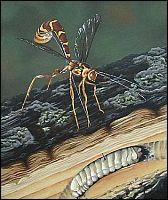
All the insectal elements were there from
the beginning - cocooning, abductions for reproduction purposes, eggs, hives.
Let's take a close look
THE PARASITIC LIFE CYCLE
The Alien is parasitic, needing a host in order to reproduce, just as the Ichneumonoidea genus of insects do, such as Ichneumon wasps (usually mis-identified as flies) and brachonids. Ron Cobb identified the paralyzing wasp as influencing O'Bannon. Brachonid's paralyze potential hosts and implant their seed along with a virus that suppresses the immune system and allows the larvae to grow undetected by the host. The large, formidable looking ovipositor of the Icneumon wasp is not used to sting, but to impregnate.
LARVAL, PUPAL AND ADULT LIFE STAGES
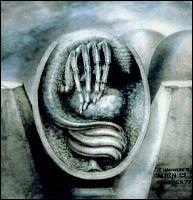
From the egg comes the Facehugger, the first stage of the Alien life-cycle. The Facehugger's function is to locate, subdue, and impregnate a host via proboscis (we can consider the Facehugger to play the role of the Ichneumon or Brachonid wasp). The impregnated host is the pupae stage. Once the Alien violently emerges from the host, it is in its 'nymph' stage of life, and like many insects it must shed its skin in order to become an adult. Butterflies go through a growing process known as Complete Metamorphosis - meaning its adult stage is completely different to its larval stage, as is the adult Alien from its infanthood as a Facehugger. Once the Chestburster has shed its skin (as most insects do, usually shedding exoskeletons numerously into adulthood) it leaves behind the instar stage of its life and becomes an adult. The four stages and drastic changes of the Alien (egg/Facehugger/Chestburster/adult) make it Holometabolous.
The chestbursting itself, or rather headbursting, is taken directly from antomology. Fire Ants have a natural enemy in the Phorid fly that lays eggs in the thorax of the ant and the creature inside moves to the head and then bursts out. It is shocking display of the effective measures parasites have of surviving. The Fire Ant's head will literally drop off and the fly will spend a further 2 weeks living in the head that acts like a cacoon.
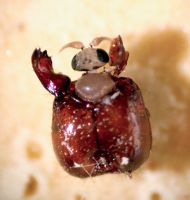
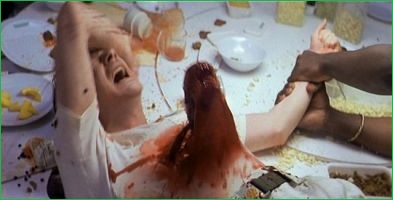
The second jaw appears in insects as well, dragonfly nymph in particular. It uses its second jaw to extend when attacking a prey even though it has mandibles. Nymphs are ferocious predators, hiding in muck on pond bottoms and eating anything they can snatch.
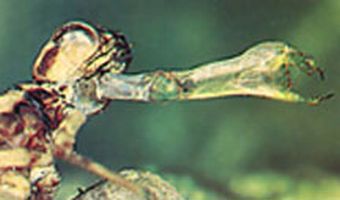
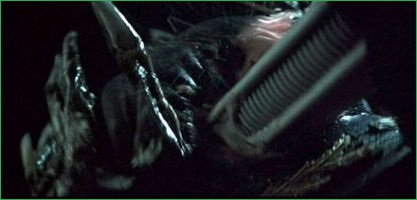
COCOONING
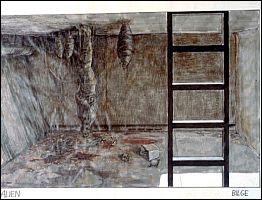
Original artwork representing Alien's lair/nest (right)
While the cocoon scene was taken out of the movie, the idea was still there. Some point to spiders as a worthy comparison to the Alien cocooning its prey, but spiders are not insects, no arachnid is. A more worthy comparison would be some wasps, such as the Cicada Killer Wasp, which cocoons its prey nearby the eggs of its young, so that the newly hatched wasps have a food source. In Alien, the Alien cocoons Dallas and Parker not to feed on them, but for reproduction, so this idea is an amalgamation of the reproductive cycle and other insectal traits.
THE HIVE
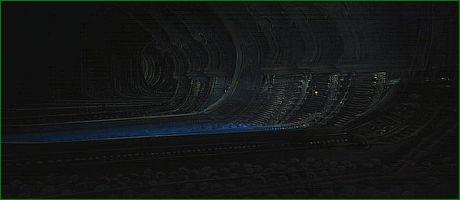
Like ants and most wasps, the alien's form a hive around the desired structure. According to Giger, the cave, or perhaps some sort of a hive is underneath the Derelict
HR Giger: '[W]e had to combine the derelict ship and the hatchery silo. I thought we could place the egg silo under the ship, a bit like termites do.' (...)
Of course, the beginning of the actual resin based hive can be seen in the deleted scene
The actual creature does not show many insectal characteristics in its body or abilities aside from being attracted to air ducts and sleeping high up near the roof/ceiling. originally, an insect like leaping from wall to wall was planned, but impossible to execute with the available technology. As a result, the alien is actually never seen taking a single step
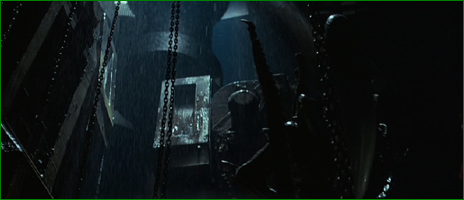
There was also a scripted scene which also made it into novelization, where alien gets lured into the air lock trap because it was attracted by blinking light, as many insects do. The scene was omitted due to budgetary and scheduling reasons, but part of it was shot. Ripley's nose bleed is a direct aftereffect of the omitted scene.
Low servo whine.
Door opens.
Slowly.
Green light throbbing inside air lock.
Creature looks curiously at it.
Moves onto the threshold.
INT. PASSAGEWAY - "B" LEVEL
Parker watches...
INT. AIR LOCK
Creature move further into air lock.
Fascinated by green light.
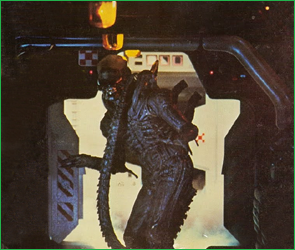
In the movie itself it's referred to as an animal ("Most animals retreat from fire"). It also doesn't feed like an insect, it feeds more like a wild animal on all the food it can find, which is something that people eat as well. There was a scene in one of the drafts of the original Alien that had the crew discover their food stores trashed and their food supplies eaten.
Either of the terms used by OBannon and Scott, natural animal and insect, can apply.
______________________________________________________________________________________

So with all those insectal traces in place, which elements borrowed from entomology did James Cameron add? Most of the groundwork in the insectal department was laid by the original alien's creators. The eggs, cocoons, hives, larvas and abductions were already there in the first movie, and made a comeback in Aliens.
One of the two things that Cameron added was the egg layer. A new, biologically and scientifically grounded answer to the eggs' origins.
THE QUEEN
In the original cut of Alien, the creature abducts Dallas and Brett, who undergo a metamorphosis into Alien eggs. The scene was cut as Ridley Scott felt it destroyed the pace of the movie, but it was also cut for other reasons as well.
David Giler: 'That sequence was taken out before the film was shown anywhere. So no one except us has seen the cocoon footage. It was removed because it simply didn't work. It interfered with the pacing of the film. It looked terrible, awful. So instead of redoing it, we decided to write it off as a bad idea.'
Ron Shusset : "When we took out that scene, the whole thing worked great, and nobody missed it.. The only reason we later put it in was we had the luxury twenty-five years later, and everybody knew and were fans of the movie by then, so we could do it. But it’s good we all came to the same conclusion, because we could have made a terrible mistake: ‘Oh, look at that great idea we had, where he says, “Kill me!” and he’s growing the egg!"
The egg morphing idea heavily resembled the ideas presented in stereotypical old B movies. The idea of a human being turned into something through the monster's enzymes/fluids was presented few times in cheap B movies before (ex. The Creeping Unknown 1956) and after Alien (Troll 2 1990).
James Cameron: An immature female, one of the first to emerge from hosts, grows to become a new queen, while males become drones or warriors. Subsequent female larvae remain dormant or are killed by males... or biochemically sense that a queen exists and change into males to limit waste. The Queen locates a nesting spot (the warmth of the atmosphere station heat exchanger level being perfect for egg incubation) and becomes sedentary. She is then tended by the males as her abdomen swells into a distended egg sac. The drones and warriors also secrete a resinous building material to line the structure, creating niches in which they may lie dormant when food supplies and/or hosts for further reproduction become depleted (i.e. when all the colonists are used up). They are discovered in this condition by the troopers, but quickly emerge when new hosts present themselves.
The Queen in Aliens was carefully calculated, based on real biology and how much bigger queens are than the regular workers/warriors.
THE SOCIAL SYSTEM
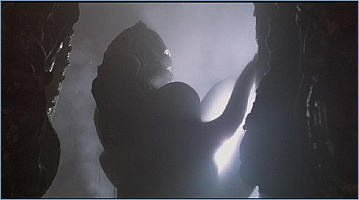
The second addition was the social system. The eusocial behavior of the aliens in ALIENS is no different than a human army (the influence was the Viet Cong). The Alien society within the Hive consists of adult Aliens, and their mother, the Queen. Unlike ants, termites, etc. the Alien Queen does not have a need for a male counterpart (ants employ drones, and termites have kings to impregnate the queen). Like the alien in Alien, the Queen is ambisextrous, a hermaphrodite, asexual, capable of reproducing without the seed of a male. (Referring to the Queen as 'she', or even as a queen is as much a contradiction as it is to label the original Alien as 'Kane's Son', as he, or it, has come to be known). The Alien Queen served to explain where the eggs came from, further drawing influence from termites which influenced the original Alien as well.
The warriors protect the hive and the Queen and individuality doesn't matter for them, only the survival of the species.
The creature itself, just like the original alien, does not show many abilities or characteristics of an insect (the visual design itself remained more or less unchanged as well. To read more go to http://www.jamescamerononline.com/AlienWarrior.htm). We see more of the aliens and we see more of their abilities, however none of them have anything to do with insects and the movie does not change the behavior or abilities of the alien at all. We see the warriors jumping on the walls but when they were jumping from wall to wall they grabbing on to something, they weren't walking on the walls or sticking to them. Every single time they had to hold, and it was their speed and grace that allowed them such movements, not any sticking enzymes or insectal characteristics.
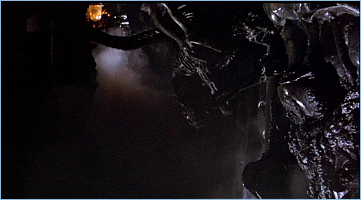
The wall to wall jumping and leaping was originally intended for the first movie, when the alien was suppose to chase Dallas in the vents, however the technical limitations did not allow it.
Ridley
Scott: ‘What I wanted was to have really huge air ducts –taller, in
fact, than the corridors in the ship - so that when Dallas first sees it there,
it’s standing on the roof of this giant wind tunnel, suspended upside down. Then
I was going to have it roar down the tunnel toward him, running and jumping
full-circle around the walls.’ (Alien: Special Effects)
Nick Allder: We were really quite limited with
what we could do with the Alien. At one point, the script called for it to run
up and down the corridors (Alien: Special Effects)
The misconception that the Warriors were walking on the ceilings then, is simply not true. They were holding on to the pipes and crates. They're holding on to things, their movements are reminiscent of mammals or animals that move on the trees. And when they crawled on the ceiling they did what any special squad or commandos would do in the same situation (ambushing targets). They did so because this way they walk quieter plus the crates simply wouldn't be able to hold the weight of the aliens and they would just fall down. Two arms and legs were used, holding strong. Bugs stick, they don't hold on.
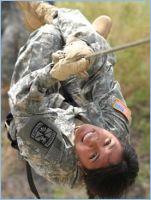
When they're waking up they were curled and moved more like snakes.
TACTICAL SOLDIERS
The aliens in Aliens are like a human army and act like soldiers taking tactical decisions and maneuvers. They do what any enemy army would do and perform the well known warfare operations and ambushing attacks. According to James Cameron in his Starlog interview from 1987, the lone alien that took care of the dropship killed Ferro to crash the dropship and leave the marines on LV-426 and cut their ammo and gun supply. Not to mention it was able to operate the door inside of it. Later on in the movie we see the aliens successfully sneaking up on the marines from all directions and meshing in with the environment making themselves invisible, like the camouflaged commandos. In considering the Vietnam conflict, the authors of Living Through History: the Twentieth Century World described a war in which the Americans brought the latest, high-tech equipment (such as helicopter gunships and rocket launchers) but were met by an enemy, the Viet Cong, who "did not fight open battles, where these weapons could be used." (Heinemann Educational, 1988, page 77.) Furthermore, after their attacks, the Viet Cong "melted back into the jungle where the Americans could not find them."
We see their efforts to exhaust the ammo of the sentry guns and then aliens retreating to make new plans. If they would stick around for few more seconds, their plan would work. Only few aliens were sacrificed in the sentry gun rush as evidenced onscreen. There's no pile of dead Alien bodies visible on the screens after they pull back, and aliens are known to successfully and very quickly maneuver all over the place. There are couple of shots which suggest they do, since we see shots of them from different position and poses, as oppose to them running into the guns. And while there's a lot of smoke, there doesn't appear to be massive acid induced damage either. Dozens of Alien deaths from the guns would leave that part of the colony falling to bits. There are also only about 30 confirmed deaths onscreen, including the sentry gun scene. The sentry guns waste ammo just like any other machine gun, it would've been a fit if they got more than some twenty aliens with those guns burning off ammo. The whole sequence was based on Battle of Alamo
Motion trackers showing only a fraction of the aliens AFTER the sentry gun battle (right)
Typically for warfare operations, they cut the power to blind their enemy, split into groups/squads and quietly sneak in on them from above, below and the back - the lone alien that Burke encounters was a part of the ambushing team, trying to cut the marines off from the other side.
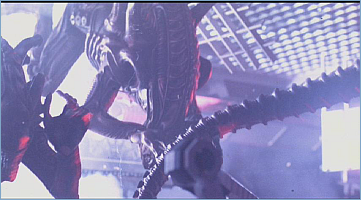
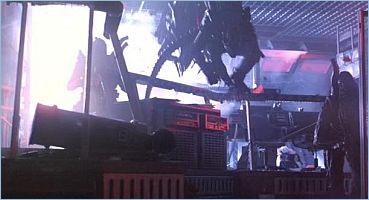
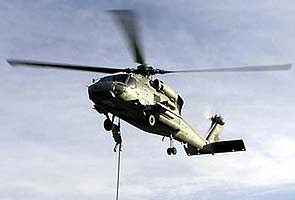
Typically for ambush Navy Seals operations, the attack starts from above
The alien battle tactics are certainly guerrilla in nature, then. The beasts use natural cover (their resin-coated caverns), pools of water, and air ducting to engage the humans in conditions favorable to their extra-terrestrial strengths. This is not a "stand-up" fight in other words. Again, consider that in Vietnam the Viet Cong was famous for using a subterranean tunnel supply system. Once more, the aliens mirror that function, taking up residence in the "sub levels" of the battlefield, moving back and forth out of easy sight
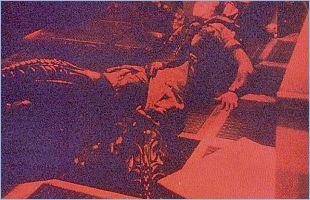
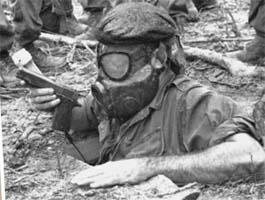
It's also worth noting that aliens behaved like military/special forces in hostage situation with Ripley and the Queen - They started moving in slowly because Ripley had a gun almost aimed at the Queen, they didn't want to risk it so they moved like all the other aliens in Aliens - like special forces, trying to get to the person holding a hostage by walking up very slowly, so they wont startle him. They did so until the Queen ordered them to back off.
The aliens of Aliens defeated a highly trained and highly equipped marines. Such approach represents how dangerous and terrifying aliens really are because they're going against military and they're portrayed as advanced military themselves. It's hard to see how lethal the aliens really are that well when unarmed weaker opponents are facing the alien. If an adult person beats up a smaller, helpless child it doesn't really show how tough he is, but if he beats up a person who's armed with knives and sticks and baseball bat then it's a different story.
Another thing worth noting is the consistency - the aliens like and move through the air ducts. Another consistency is in alien's feeding. Aliens follows the suit of the original idea and James Cameron mentions that aliens become dormant when 'either hosts or food supplies become depleted', pointing out that its not one and the same.
Just like in the original
movie, the alien is referred to as an animal ("How can they kill the power,
they're animals!"). The movie never refers to the aliens as bugs. The first
instance of the word 'bug' is spoken by Hudson:
Hudson: Is this gonna be a standup fight, sir, or another bug hunt?
Bug hunt refers to a mission without combat. Also, it could not refer to the
Aliens, since the Marines had never come across them before. The second
reference to a bug is in the Director's Cut, during the discussion of the source
of the Alien eggs. The reference is quickly shot down by Vasquez, and Hudson
concedes
______________________________________________________________________________________
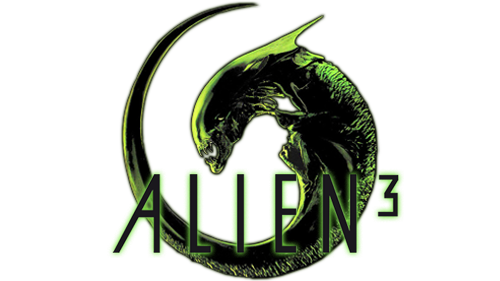
Alien 3 pushes the envelope much further towards the insect side than the other two movies and almost fully transforms the creature itself into a space insect. The Alien seemed to have picked up plenty of insectal abilities (while loosing the biomechanical aspect of its design).
CRAWLING ON THE WALLS AND CEILINGS
Climbing, crawling Aliens in Alien and Aliens tended to need support, especially when crawling upside down, as the invading Aliens do during the Operations attack in Aliens. The Runner Alien it seems, didn't need any support at all, like insects.
David Fincher: 'We wanted the creature to walk on the ceilings and really sell the idea that this thing is a bug from outer space.' (Cinefex)
Laine Liska, Alien 3 puppeteer: 'He [Fincher] wanted it to move more spidery, almost like an insect.'
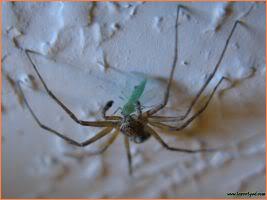
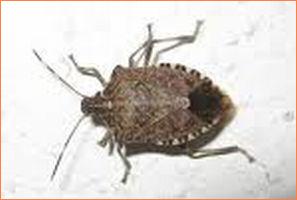
Same goes for freely walking on the walls sideways. It was freely running on the ceiling and walls sideways without holding on to anything. While running, the alien Runner even made a similar sound to a tapping cockroach
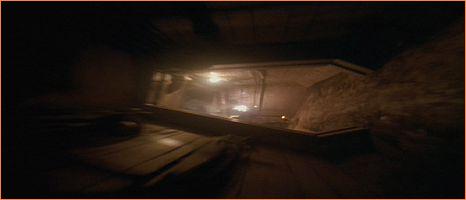
SPITTING ACID
Another insectal trait exclusive to the Alien 3 Runner was the ability to spit acid/mucus at enemies, an ability belonging to ground beetles, walking stick, and several kind of ant. An interesting ability of the Camponotus saundersi ant is to rupture its poison glands upon injury or death, spreading mayhem in all directions
EATING VICTIMS
As oppose to the aliens in the first two movies which fed on food supplies that they could find and that were also suitable for human beings, the Runner ate his victims with ferocious appetite and ate almost each and every one of them. Many insects and some arachnids eat only living or freshly killed food and are carnivorous only. The scrip and the novelization describes the alien as eating/devouring the prisoners. "Fincher’s idea was that the creature simply kills to eat" said Tom Woodruff Jr in Cinefex Magazine in '92
It also slept in the cellar with maggots and spiders.
Also, in Alien 3 it's the first time an alien is referred to as a bug ("I hate bugs!")
From the fears and morbid interests of Dan O'Bannon, through Ridley Scott's research into insects, and Ron Shusset's declaration that an insect life-cycle was the intention, it cannot be denied that the Alien is an amalgamation of horrific sexual aesthetics and insectal traits, which both contributed not only to the nightmare inducing nature of the Alien, be it the creature's abilities, its visage, its growth cycle, but to its integrity as a space dwelling avatar of death as well. Strip the Alien of all insectal traits and nothing reminiscent of the series' Xenomorph is left. Alien, Aliens, and Alien 3 managed to equilibrate the sexual and insectal overtones to create a startling, original beast, an equilibrium upset after the third installment, which saw dilution of the creature's sexual elements, and diminishing returns.
Written by Johnny D. Kennedy and Adrian Czarny